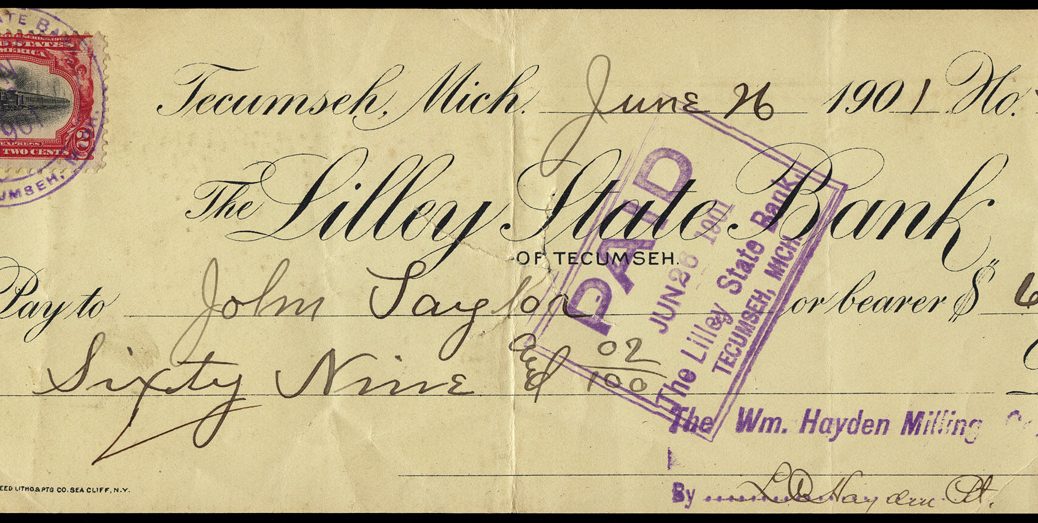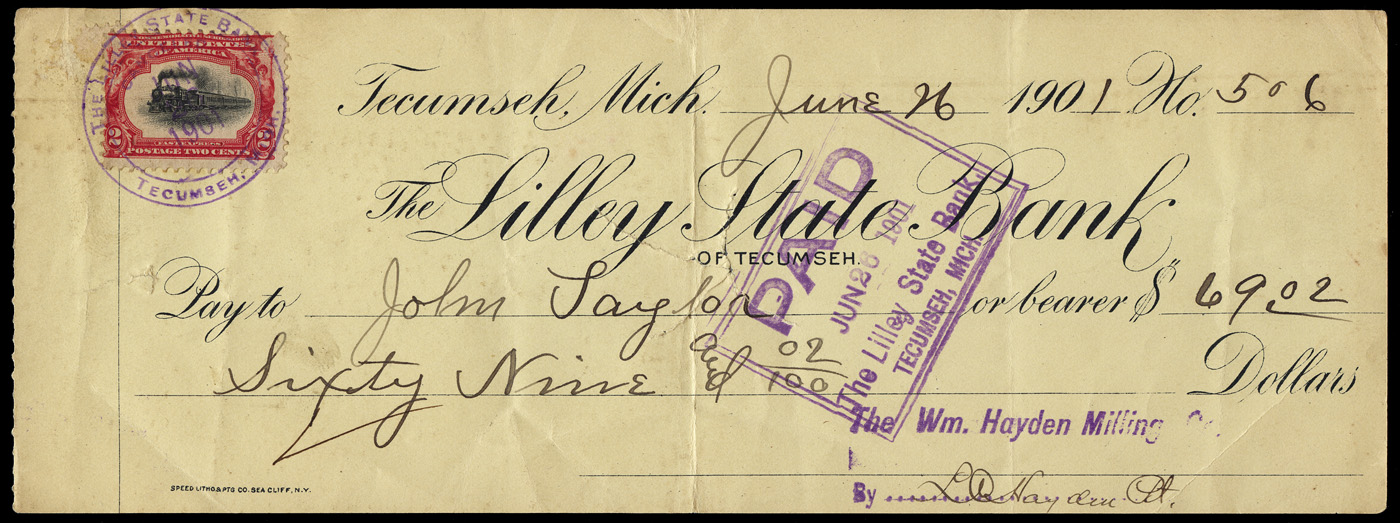
Illegal use of 2c Pan American as revenue… but is it legit?
When I purchased this a year ago, I didn’t realize just how scarce an item it actually is; it just happened to fit into my collection of illegal usages. It turns out it’s much more scarce than I initially thought.
The 2-cent Trans Mississippi (Scott 286) can be found used illegally as revenues, usually ranging from $100-250 on document. They’re not common, but can be found. I have 5 examples on documents and another single not on document. They’re out there…
… and yet the 2-cent Pan American (Scott 295) isn’t. I spoke with Eric Jackson at CHICAGOPEX last month about the one I purchased, and he was surprised I had one. He said he’s never seen one.
I think there are several reasons why these are so scarce (in this case I should probably use the word “rare”, which IMO should be reserved for special occasions):
- The vast majority of illegal usages occur in the first 6 months of the tax (July-December 1898) when supplies of revenue stamps were still making their way out into the field, where certain municipalities may not have yet received their allotment or ran out due to incorrectly estimating demand/need. The 2-cent Trans Missippi was issued prior to the tax and thus was available throughout the entire period of the tax.Yes, there are later illegal usages, but those tend to be isolated and/or regional in nature and are fewer in number.
- The Pan American series was issued on May 1, 1901 and the last day of the tax was June 30, 1901. That’s a 61-day window during which an illegal usage of a stamp from the Pan American series could possibly occur. That’s an awfully small time period, compounded by the fact that by that point, revenue stamps were hardly in short supply. The example below is dated 4 days before the end of the tax.
I’ve not seen reference to or image of another example…
Follow-up. I asked Richard Friedberg whether he had seen any Pan Americans illegally used as revenues. His reply:
Have not seen any. By the time this stamp was issued there were plenty of R164’s available so I would be skeptical of such a use. Years ago someone “discovered” one-cent Pan Ams used as a revenues, but they proved to be fakes on inspection.
I then sent him the above image. His reply:
Interesting in that the fake one-cent stamps were also used in Michigan. The 2-cent usage is almost too good, in that most items are not so well-tied. Possibly someone obtained the bank handstamp, or maybe they really ran out of one and two cent stamps in Michigan in mid-1901? Or did not re-order once their supply was depleted. I am not sure what to think of this item.
My response:
Michigan, for some reason, seems to have had a lot of illegal usages. I don’t know if there were distribution problems or something else.
I have a 10-cent Trans-Mississippi used as revenue on a marriage certificate from Huron County in June 1899. At Chicagopex this year, when Mike Morrissey, Bart, Bill Halstead and I were trading material, Mike had another identical marriage certificate with a 2.5-cent Proprietary block of 4 used to pay the 10-cent tax – same county dated 8 days after the one I had.
That block of 4 of #273 second day usage document I bought from you 2 years ago was from Port Huron, Michigan.
One of my 2-cent Trans-Mississippi illegal usages is also from Michigan.
I have a 279B on a check from Eaton Rapids, Michigan dated August 24, 1900 and two #267 on checks from Port Austin, MI in 1898.
The only other geographic “cluster” of sorts for illegal usages from the 1898 era I have been able to identify is rural central and western PA, but that pales in numbers compared to Michigan. Pretty small samples to draw conclusions from without a real census, but MI leads all other states in my collection in terms of numbers.
There does appear to be some stamp residue to the upper left of the 295. If I were going to manufacture an item like this, however, I would not leave the residue at upper left…
I disagree with the implication that the fact that it is well tied is a possible indicator that it is not legitimate.
The vast majority of illegal usages (within the Civil War tax era, the check tax only period of the mid-1870s through 1880s, and the Spanish American War era) are manuscript cancels, which as a general rule are not tied. However, I do have several Spanish American War-era illegal usages that are handstamped, tying the stamps to the document. There are also other high-profile/high-scarcity illegal usages from the Civil War era that are handstamp canceled, and I’ve never heard it posited that they might be spurious based upon having a socked-on-the-nose handstamp.
Here is a higher resolution image including a closeup of the stamp.
The one thing I have not done is to try and find out if this cancel is appropriate for 1901, as opposed to a later one that someone used to “manufacture” the item.
Thoughts?
Response from 1typesetter:
What would concern me is the upper left corner where it looks like a stamp may have been removed.
Response from rwoodennickel:
The 3 purple hand-stamps are of the same ink and date. So I would think it was not a forged cancellation. Perhaps the wrong tax amount was applied to the document, then removed for the correct rate.
Response from 51studebaker (Don Denman):
My opinion… The adhesive causes pause. And the challenge with extraordinary items is that they need extraordinary provenance or evidence. A unique item is an item that needs to be verified beyond reproach. So I agree that further discovery needs to be done on the cancel type and usage period. Turning up another document from this period with the same cancel would be a strong indication that this is not faked. Without it, questions and speculation would always remain.
Response from bookbnrbob:
There appears to be 2 areas of concern: 1.) a stamp has been removed where a revenue stamp would typically appear, and 2.) the purple ink of the Wm. Hayden Milling Co. appears to be the same as the purple ink of the Lilley State Bank.
My response:
I’m not sure exactly what the variance (or lack thereof) in the shade of purple cancel tells us. By the turn of the century (compared to the Civil War era material), there was far more consistency in color mixing, IMO.
Response from mdroth:
The fact that the ink is the same for all 3 hand stamps is not odd at all. My guess – only a guess – is that all 3 hand-stamps were applied at the same time, at the same place (the bank!), from the same ink/stamp pad – likely by the same person.
I don’t think the fact that the ‘milling company’ ink & the bank ink are the same tells us much in this case – other than they were probably done at the same time with the same ink.
The old stamp remnant is certainly the strangest aspect of this to me – I like the explanation that the wrong amount was initially applied. But I see nothing that would say that this is a ‘forged’ “illegal” use – (if there is such a thing?!)
Great find & a very interesting case. We need a turn-of-the-century local bank/hand-stamp expert from Michigan…
If someone knows the proper amount of ‘tax’ required on a $69.02 check in June 1901, that would also shed some additional light on the case…
Response from reveuermd (Ron Lesher):
The correct amount is 2 cents. The tax was the same on all bank checks regardless of the amount of the check.
Response from revcollector (Bart Rosenberg):
R156-R158 were also used in Michigan, in 1898. The obvious remains of another stamp makes this highly suspicious, by 1901 the tax was 3 years old and no one is likely to have not known the tax rate. Purple ink was in very common usage at the time, so matching it would probably have presented no real difficulty.
Response from rwoodennickel:
While I have to agree that suspicious is accurate, why would someone leave remnants of another stamp if trying to create a philatelic curiosity? If one would go through the trouble of matching ink, obtaining a cancel device,then why not soak the stamp off? Maybe to spark debate in 2017. Still a great item to discuss, maybe another like usage will surface in the future.
Response from revcollector (Bart Rosenberg):
Who knows? Perhaps they didn’t notice. But I have seen many dozens of altered stamps that are obvious in 5 seconds or less; remains of perfs, or remains of cancels, or some other obvious giveaway.
My response:
Barring a corroborating example (highly unlikely) or at the very least some sort of confirming or negating example of when that cancel was used, we’ll likely never know for certain.
The person selling it was doing so for an animal rescue shelter benefit, so even if bogus the money went to a good cause. I won’t be upset if not legit. If nothing else, it’s an interesting discussion piece.
Response from 51studebaker (Don Denman):
The theory about not removing the previous stamp residue while faking the rest of the document makes sense. That said, are there any non-philatelic reason(s) that that someone might have added a stamp at a later date? Anyway to search to see if there was any kind of legal action related to this doc?
There was no further discussion after this point. I would love to see additional examples of the handstamp canceling the stamp to know whether it was appropriate for that period.

